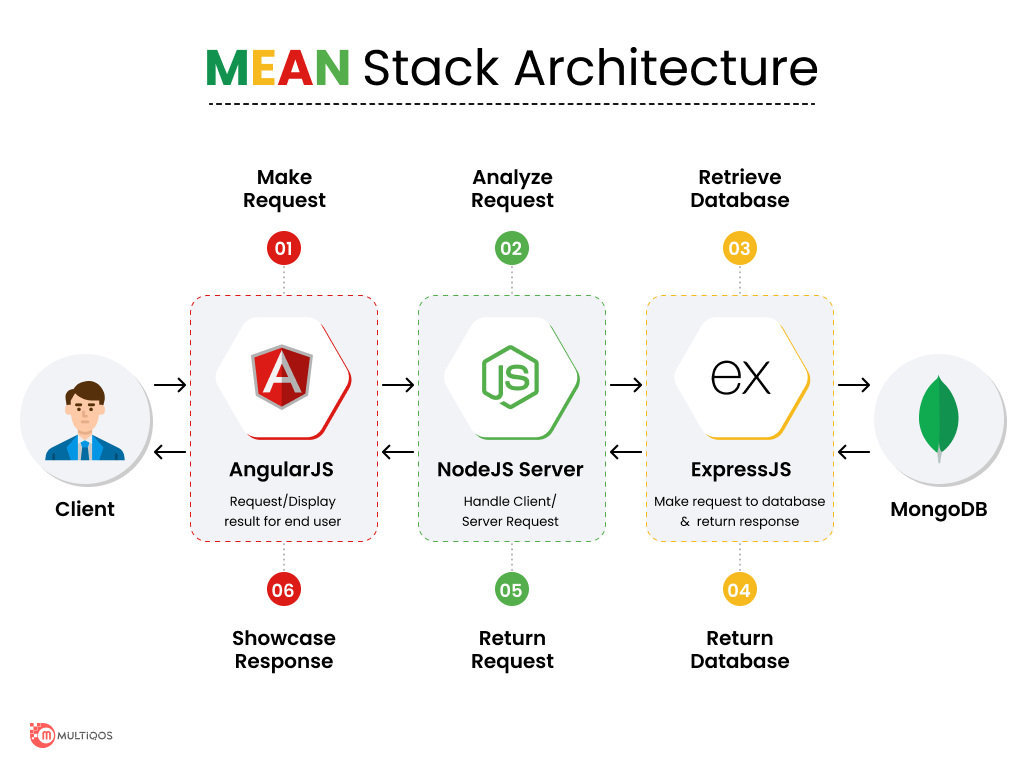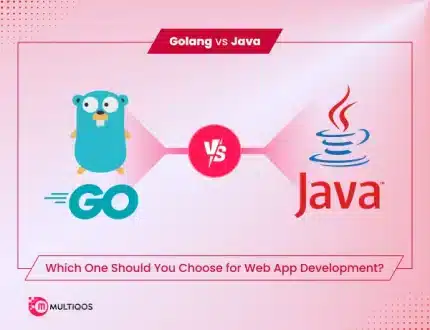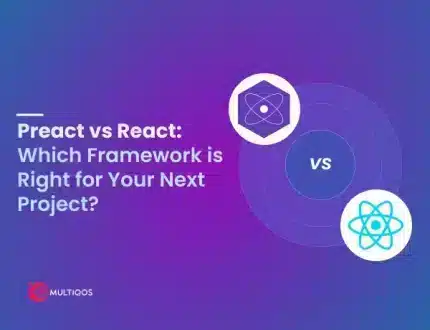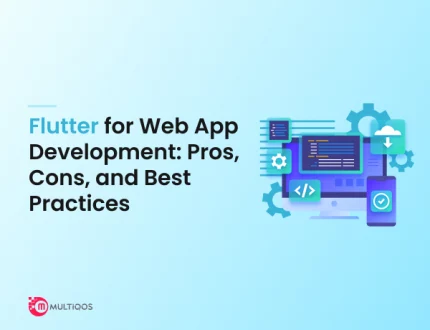Enterprise Application Development with MEAN Stack: Why Use It?
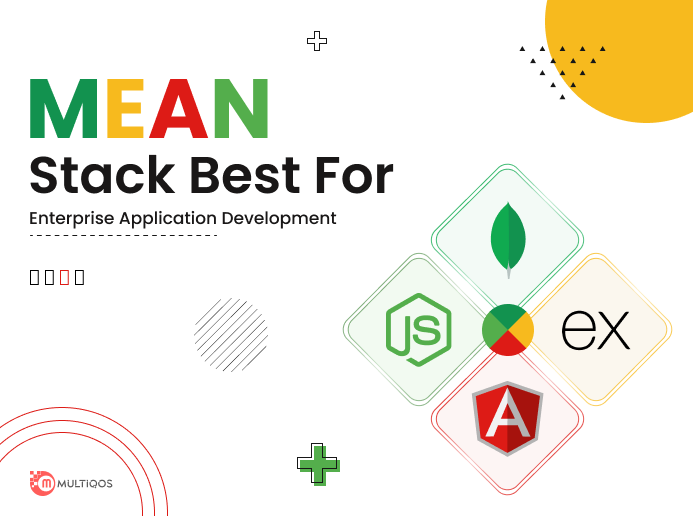
Introduction
When it comes to starting a new business or revamping an old one, there is a wide range of factors that a business owner must consider. “What should be the appropriate technological stack” is one such variable.
While there is a ton of blogs that may go into great depth on technology, we know that company owners want someone to persuade them that how a certain technology stack would enable them to expand their businesses smoothly.
This article seeks to dispel any confusion about MEAN Stack and assist company owners in making an informed technology stack selection. Let us get started:
What Is the MEAN Stack?
MEAN Stack is a tool for developing JavaScript websites that depend on four architectures: MongoDB, Express, Angular, and Node.js. They together make up the acronym MEAN.JS. A document-oriented data model is used by MongoDB, an open-source NoSQL database. This shows that, as opposed to rows and tables, its architecture is made up of document collections. The architecture is both scalable and capable of processing large amounts of data.
Due to its quick and well-organized way of working, most mobile app development companies are picking this open-source stack. The language used is just one of the many benefits offered by MEAN stack. All applications have used JavaScript, which is a single language. This feature not only modernizes the approach to web and app development but also makes it quite efficient.
What Are Analysing Aspects of the MEAN Stack?
The AngularJS framework in JavaScript operates using client-side language. As a result, AngularJS processes every request that a user makes at the beginning. The second step of the program, Node.js, is then reached. Another name for this stage is a server-side language. Next, the request is sent to ExpressJS, often known as step 3. Phase 3 of the process begins with a request to MongoDB, which completes the whole data retrieval process before sending ExpressJS the answer. ExpressJS transmits the data it receives to NodeJS, which then returns the response to AngularJS.
Let us analyze them one by one!
-
MongoDB
Since it houses all of the application’s data, MongoDB is crucial to the MEAN stack. Since both the application and the database use JavaScript, MongoDB does not require any additional translation when an object is sent from the app to the database. The scalability of MongoDB in terms of storage and throughput is well known. When utilized with enormous amounts of data, it is also renowned for providing flawless management. Without having to refresh the entire table, it enables the user to include fields to the database.
-
Express.js
Express.js makes up the MEAN stack’s backend. It helps with the management of interactions between the database and the front end. The end-user receives a seamless data transport thanks to Express.js. Noting that it adopts a minimalist strategy is also crucial. This indicates that Express.js has the ability to efficiently manage all of the processes. Express.js can avoid variable data corruption which adds up as a crucial feature. This feature reduces the likelihood that the user may unintentionally redefine previously defined variables, saving both time and money.
-
EANAngular.js
AngularJS is a generally recognized JavaScript front-end framework. In the MEAN stack, AngularJS is effectively utilized to create the user-facing portion of the application. Since the backend, database, and frontend of the program are all developed using JavaScript, there is seamless data transfer among all of its components. AngularJS development is the best front-end framework because of its fine-tuned performance and simple structure.
-
Node.js
The MEAN stack’s foundation is made up mostly of Node.js. It’s vital to remember that Express.js was created expressly to run on top of Node.js. In order to provide quick data serving, AngularJS is now easily integrated into Node.js. It’s also important to realize that Node.js includes a built-in web server, which enables one to arrange the MongoDB database to the cloud. It can handle millions of connections at once. The compatibility of Node.js enables it to operate under low-resource requests as opposed to resource-intensive assets.
While all of these technological aspects cover different phases of your app development journey, you must know why to actually deploy one.
Why Should You Choose MEAN Stack?
There are so many different factors that business owners must consider. Let us see how MEAN Stack allows them to grow the business seamlessly:
-
Minimal Cost
The cost factor is the one factor that might make or ruin the company since overflow can undoubtedly force us to make some difficult decisions. Here, Mean Stack steps in to save the day. The resources for this domain are economical since it makes development a piece of cake. Additionally, it uses fewer technology, which means fewer resources are needed. Additionally, you are set to go if your IT crew is knowledgeable in JavaScript.
-
Scalability
Entrepreneurs start their businesses in the hopes that millions of people would one day appreciate their product. And if your technological infrastructure cannot manage the strain or provides users with subpar service, that would be a nightmare. Mean Stack is a rock star in this situation too. Node.js development non-blocking feature is essential to servicing millions of visitors. Further, if the cloud architecture is supported by the appropriate settings, you may develop a very effective, scalable tech solution for your company.
-
Cloud Compatibility
Install at your convenience and from any location around the world. All you need are clearly stated business needs. You should be able to build up cloud infrastructure thanks to your Mean stack team. Using the cloud as opposed to physical memory in your tech solution greatly reduces your expenditures.
Additionally, there are a number of built-in features in well-known cloud solutions like AWS that assist protect your solution from hackers. Additionally, the Mean Stack architecture’s many additional DevOp tools, which are simple to use, assist you in streamlining your development process.
-
Ease of Debugging
Finding production-level problems can be difficult. It may completely alter the perception of your brand. Today’s e-commerce platforms, for instance, offer significant discounts throughout the holiday season. While there is no technology-free solution, you never want your company to suffer in these situations, especially if your staff is unable to find and resolve the fault in a timely manner. Therefore, pick a tech stack that is simple to troubleshoot from the start.
-
Amazing User Interface
As the saying goes, “First impressions matter.” Users will benefit greatly from a flawless experience with your mobile or online application, which will undoubtedly contribute to the essential growth of your company. Mean enables programmers to construct top-notch user interfaces that provide exceptional experiences for end users using the MVC framework. All businesses, whether B2B, B2C, or B2B2C, can benefit from it.
-
Open Source
What initially comes to mind when we hear the term “open source”? Well, it’s free! The concept of open source encourages the developer community to become a better version of itself. To that end, the developer community’s joint efforts help your solution, as a business, stay current. It undoubtedly aids in keeping you one step ahead of your rivals.
-
Vast Plug and Build Library
Developers using Node.js are lucky to have access to libraries that not only speed up the entire development process but also improve the effectiveness of solutions. How? Libraries, on the other hand, are prepared to employ codes that have been examined by the developer community. Furthermore, if you were to create such modules on your own, it would take a lot of
-
Minimalistic Language
Javascript serves as the foundation for Mean stack’s whole ecosystem. Imagine the degree of code cleanliness and architecture robustness that would result from the team not having to fix solutions created in several languages, among other things. Yes, you may accomplish this for your product by selecting the proper stack.
-
Monolithic/Microservices Architecture
While certain unique situations call for the creation of a monolithic architecture, the majority of contemporary technological solutions call for the creation of a microservices architecture. Your tech staff may simply construct both designs thanks to the MEAN stack. In actuality, MongoDB’s charm lies in the fact that it enables you to always build a highly available and fault tolerant system.
Additional Benefits of Using the MEAN Stack for Enterprise Applications
Numerous individuals are still unsure about what kinds of projects you can choose to develop with MEAN Stack even after reading about the features of the MEAN Stack that already give strong reasons to choose it for corporate app development projects and understanding how each of its frameworks contributes to this stack. The MEAN Stack is the ideal technology for building enterprise applications, web apps, dynamic SPAs, complicated business apps, social networking apps, and more.
It can be used for different types of applications including;
- Web Apps for Bigdata
- Real-Time Applications
- Streaming Apps
- Enterprise complex apps
- Secondary business apps
Which Applications Are Crafted with MEAN Stack?
According to the enterprise web application development services, there are eight real-life applications developed using MEAN Stack:
- Youtube
- Netflix
- PayTM
- Tumblr
- Forbes
- Flickr
The IT specialist you select to hire for the project and their talents will have a major impact on how MEAN is used. Everything depends on their knowledge and experience, specifically how they may benefit the most from this. Additionally, it depends on the project’s scope and magnitude.
Also Read: Best Examples of Websites and Applications Developed with Angular.
Are MEAN Stack and Full Stack Different?
The MEAN stack and full stack development are very different from one another.
In the case of full-stack development, there are many different front-end and back-end frameworks. Therefore, you must select from a variety of programming languages, like PHP, JavaScript, Python, Java.Net, and others. The MEAN stack, on the other hand, only uses JS programming languages. Therefore, there is no participation of other languages, resulting in competent and well-organized growth.
Key Takeaways
The MEAN stack technology is both simple to use and improving daily. The advantages that the JS basis offers are more than enough to support the MEAN software stack. It offers the ability to regulate the technological stack needed to create safe web applications and other business solutions. Study up on selecting the ideal technological stack for your project.
Many people have taken this into account and used MEAN stack development for their technological endeavors. So, don’t pass up a technological stack that may help you obtain quicker, safer, and more affordable solutions for your company!
Want Transform Business with Custom Enterprise App Development.
Consult a Domain Expert Free of Charge and Get an Estimate.
FAQs on Enterprise App Development Using MEAN Stack
Express.js is mostly used for back-end development. It makes it simple for you to build web applications. It also offers you a straightforward interface for managing requests and cookies.
The inclusion of JavaScript, a widely used language, is one of the main factors contributing to the MEAN stack’s popularity. Both clients and servers can use it.
Numerous well-known businesses use MEAN Stack which includes Accenture, Fiverr, UNIQLO, Google Vungle, AngularClass, and even Sisense.
Get In Touch

